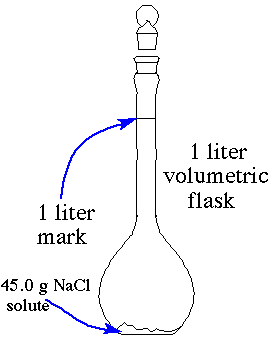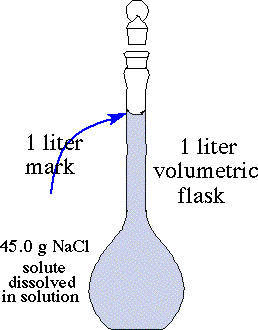Concentration: Molarity
Concentration: Molarity
|
Concentration: mols per liter of solution |
|
Concentrations are always ratios of solute to solvent. The different types of units have funny pecularities. The solute is always inthe numerator of the concentration units. The most commonly used chemistry concentration unit is molarity.
Molarity = mols solute/ liters of solution |
|
I hope you are wondering why concentrations are necessary. Why on earth does anyone care about concentrations of solutions? There at least two reasons for creating concentration units. One reason is that when you study kinetics you learn that concentration influences reaction rates. Higher concentrations mean faster reactions. Another reason is that reactions depend on moles of reactants. The moles of chemicals can be measured using volumes of solutions instead of weighing out masses. Measuring volumes is very simple and cheap compared to measuring masses. Solutions of known molarity are made by weighing out a definite number of grams of solute. The solute is placed in a container that has a calibrated volume, like a volumetric flask. A solvent is added to the flask to bring the solution volume to the calibration mark.  
|
|
Example 1: |
|
What is the molarity of a solution made using 45.0 g of NaCl and enough water to give 1 liter of solution? Click here for answer |
|
|
|
Example 2: |
|
How many moles of solute are in 682. mL of 1.5 M NH3 solution? Click here for answer |
|
|
Example 3: How many grams of solute are
in 2.4 mL of a .02 M H2O2
solution? Click here for answer
All rights reserved 1997-2005 Dr. Walt Volland
revised March 29, 2005